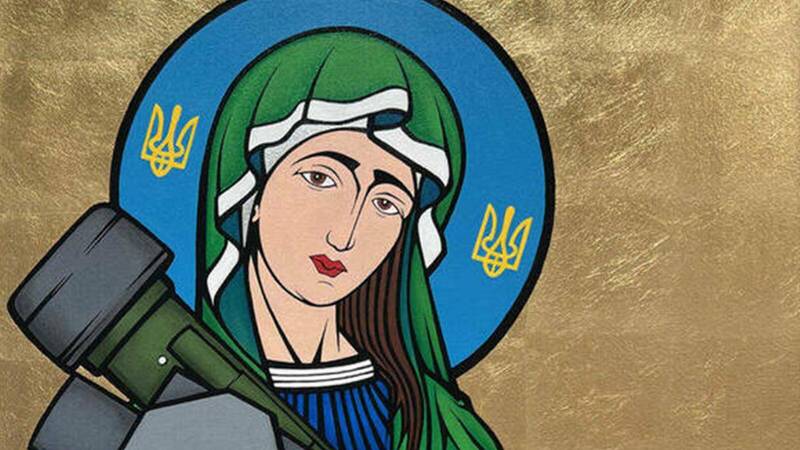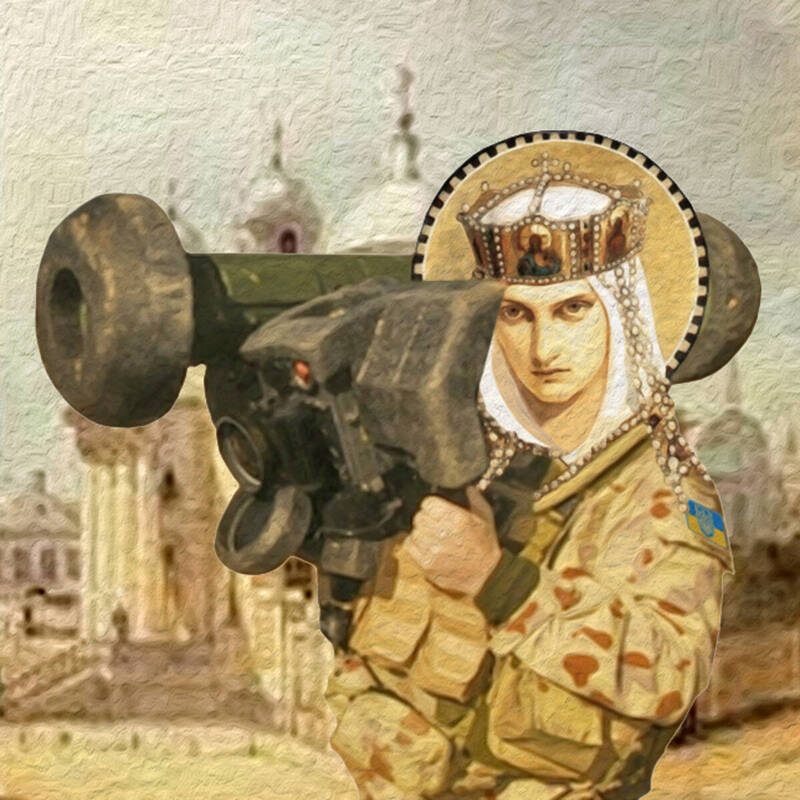
Icons in Digital Art
Ukrainian Art as Protest and Resilience
Research by Emma Ackerly ’23
Title: “Saint Olha of Kyiv”
Artist: Ivanka Siolkowsky
Format: Digital art
Placement: Online gallery, social media
Ukrainian Canadian artist Ivanka Siolkowsky’s “Saint Olha of Kyiv” is a meaningful and thought-provoking piece of art that combines traditional Ukrainian iconography with a poignant contemporary political message. The depiction of Saint Olha in military uniform, armed with a surface to air missile, is a bold reimagining of this historical figure and a commentary on the ongoing resistance against the Russian invasion in Ukraine. The artwork tells the story of Ukrainian bravery and resistance not only in the past, but also in the present, and highlights in particular how women have shown great courage and defiance in the face of adversity.
Saint Olha of Kyiv (Княгиня Ольга) is revered in Ukraine for her role as the patron saint of both defiance and vengeance. She lived in the 9th and 10th centuries and was the first female leader of Kievan Rus, a medieval state encompassing a large territory that included parts of modern-day Ukraine, Belarus, and Russia. Olha is celebrated for her efforts to promote Christianity in her kingdom and for her military prowess. Among the most famous tales of Olha’s bravery and cleverness are her successful defense of Kyiv against foreign invaders, including the Drevlians, a tribe that had killed her husband, Igor of Kyiv.

Saint Olha of Kyiv was the first female ruler to be canonized by the Orthodox Church, making her a significant figure for women in Ukraine and beyond. Olha is remembered for her intelligence, wisdom, political and diplomatic acumen, and as a powerful leader who made a significant impact.
Thousands of women have joined the Ukrainian military in combat and non-combat roles since the full-scale 2022 invasion. The number of women serving in the military has increased from around 32,000 to upwards of 50,000, with about 10,000 on the front lines or in roles that could potentially send them to the front lines. Millions of other women have mobilized in support of war efforts through, for example, humanitarian work. Depicting Saint Olha in a modern context not only personifies the bravery of the Ukrainian people amid hardship but also highlights how Ukrainian women have shown great courage and defiance in the face of Russian aggression.
Ukrainian icons and other items of cultural and religious significance have historically faced persecution and destruction, including during the Soviet era, and now Ukrainian culture is once again facing threat of erasure.
Siolkowsky’s incorporation of traditional Ukrainian iconography adds a cultural and historical element to the work that deepens its significance. In addition to its important role in religious life and prayer, iconography is a rich and meaningful form of Ukrainian cultural expression. Ukrainian icons and other items of cultural and religious significance have historically faced persecution and destruction, including during the Soviet era, and now Ukrainian culture is once again facing threat of erasure.
Despite attempts at suppression, Ukrainian iconography has continued to thrive and be passed down through generations, including in diaspora communities such as those in Canada and the United States. Siolkowsky’s integration of traditional iconography into anti-war art highlights the intersection between Ukrainian folk art and Ukraine's sovereignty and cultural autonomy. “Saint Olha of Kyiv” exemplifies how art can be a tool of resistance and a means of promoting national identity and pride.
Siolkowsky was born in Canada but her Ukrainian roots run deep. All four of her grandparents arrived in Canada from World War II displaced person camps after being forcibly taken from their villages in Western Ukraine. Siolkowsky was immersed in Ukrainian culture from a young age, growing up speaking the language, attending Ukrainian school, and participating in Ukrainian dance and scouting. When the first Russian strike hit civilians on February 24, 2022, Siolkowsky could not sit idly by. She immediately booked a flight to Poland at the end of that week, and did not waste even those few days at home.
Siolkowsky joined a group of friends to form a creative organization now known as Saint Javelin whose work raises money for the Ukrainian army. To date, Saint Javelin has generated millions of dollars with Siolkowsky's designs, such as “Saint Olha of Kyiv,” among its bestsellers. After her work with Saint Javelin in the immediate aftermath of the full-scale invasion, Siolkowsky redirected her energies to volunteering and humanitarian work in Ukraine.
Through the creation and sale of their art, Ukrainian artists like Ivanka Siolkowsky and the group Saint Javelin are not only helping provide financial support to the Ukrainian army, but are also spreading a message of resistance and resilience. In a powerful moment, Silkowsky recalls sitting in a bus station when a soldier approached, on his way to fight in Ukraine. “On his gun case was my Saint Olha sticker. I didn’t say anything to him. We merely made eye contact and nodded, but it was a special moment” she said.
Siolkowsky’s art has made its way around the world, through stickers, t-shirts, and other merchandise sold on the Saint Javelin website but also through social media — a testament to the role of wartime art as a democratic public space, for both creators and consumers, that protests and shows resilience in the face of Russian aggression.
Research by Emma Acklerly ’23
Header image: “St Javelin” by Chris Shaw, acrylic and metal leaf on canvas, completed in March 2022. Image used with permission from Chris Shaw and saintjavelin.com.
Art by Ivanka Siolkowsky for saintjavelin.com. Images used with permission from the artist.
Read the project introduction and background.